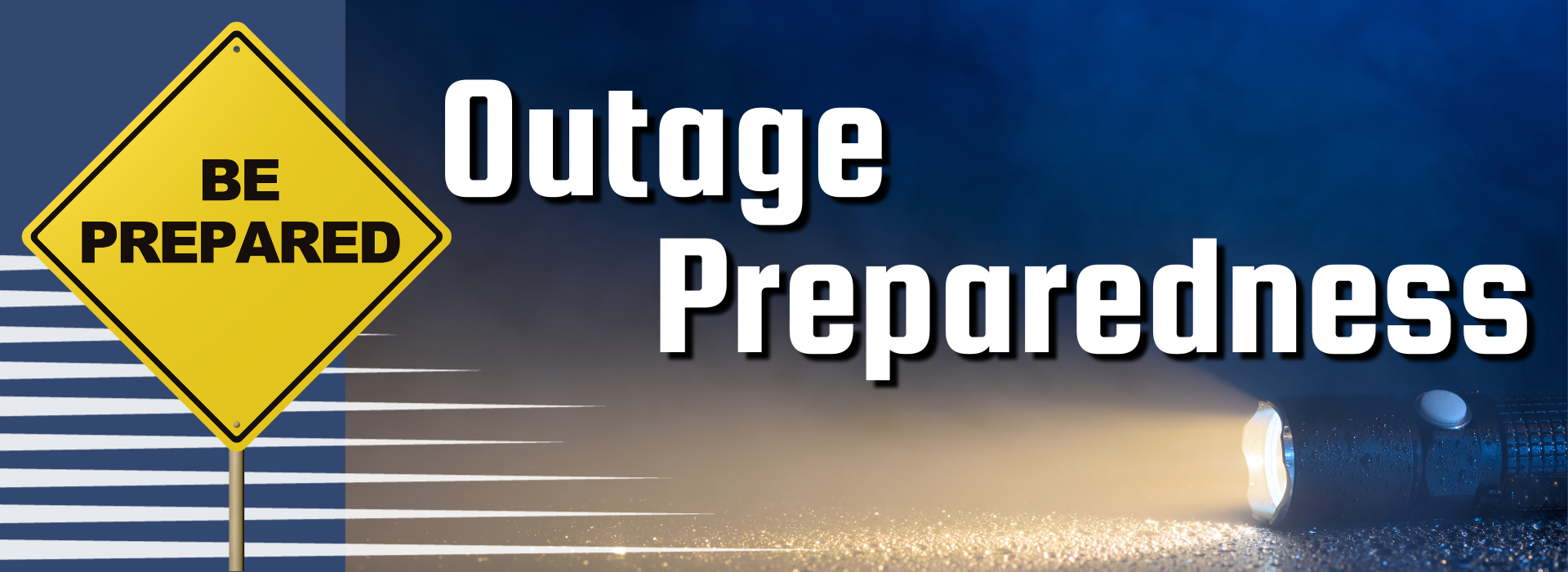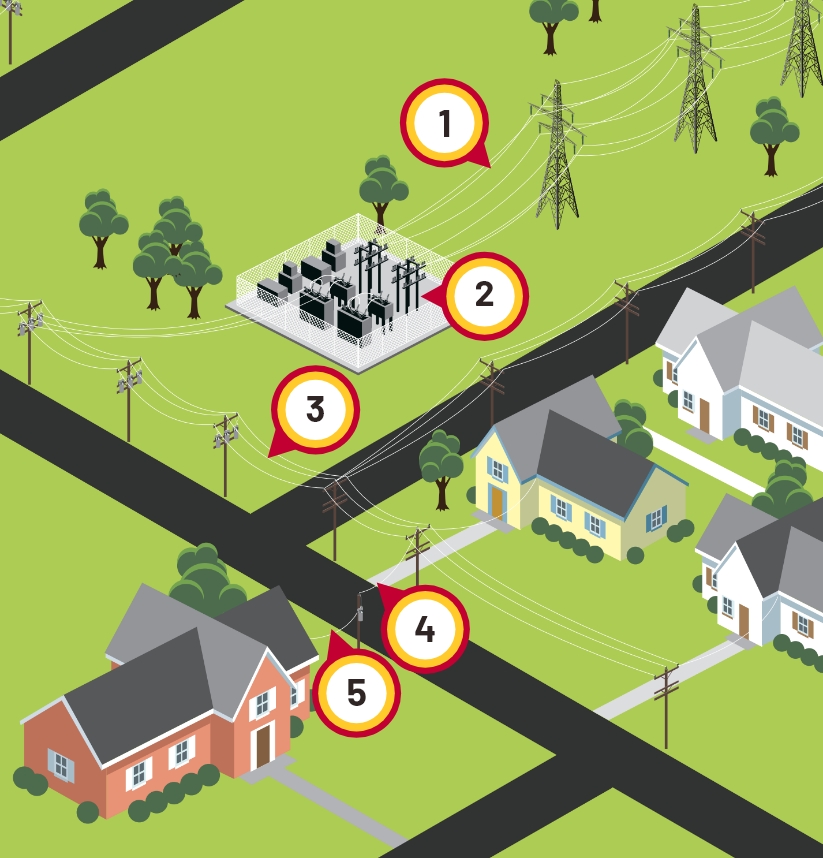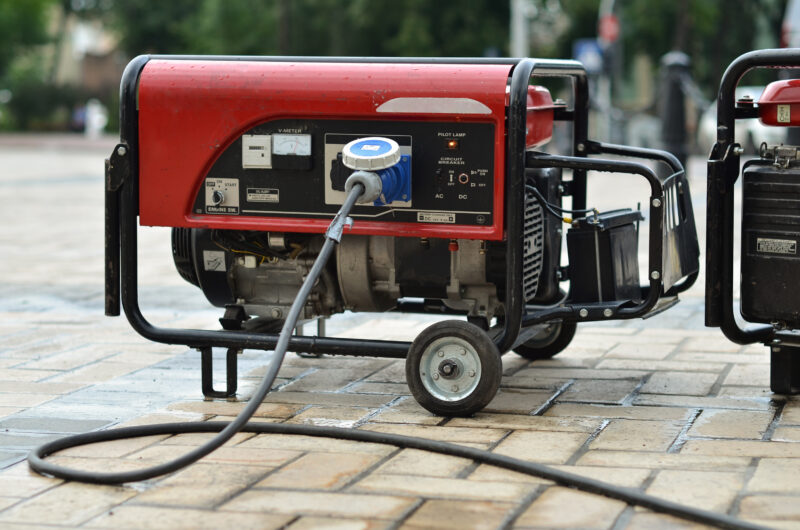
Staying Prepared and Safe During Power Outages
Power outages can occur unexpectedly, and being prepared can alleviate much of the associated stress and potential danger. Read the following guidelines to better equip yourself and your family for unforeseen power loss, with a focus on safety measures, essential items to have on hand, understanding the causes of power outages, and specific advice for people with disabilities.
What to Do If the Power Goes Out
- Check breaker box: Check your fuse or breaker box for blown fuses or tripped breakers. If they’re okay, see if your neighbors are without power.
- Report immediately: You can report via your SmartHub app or call 855-940-3918 to report.
- Turn off electronics: Turn off all electrical equipment and appliances that were on when the outage occurred to help avoid damage when power is restored.
- Watch for Updates: Listen to the radio (battery-powered, also have backup batteries) for updates on major storms, several TV stations also stream updates via their social and webpages.
- Check for outage information: Visit our social media pages and Outages webpage.
- If lights are dim: If your lights are very dim or too bright once the power is restored, turn off the power at the breaker box or fuse box and report.
Essential Items to Keep Handy
- Flashlight
- Battery-powered radio and extra batteries
- Bottled water
- Battery-powered or wind-up alarm clock
- Manual can opener
- Paper plates, plastic utensils, standard or cell phone, first-aid kit, non-perishable food items, medications, blankets, bedding or sleeping bags, phone numbers of law enforcement offices, and emergency management agencies.
Downed Power Line Safety
- Report any downed power lines immediately, maintaining a safe distance and keeping children and pets away.
- If a power line falls across your vehicle, stay inside until help arrives.
- Remember, if a power line is touching someone, do not attempt to help. Call 911 immediately. Your safety and the safety of others is of utmost importance during power outages.
Causes of Power Outages
- Trees
- Digging
- Lightning
- Animals and Birds
- Auto Accidents
- Equipment Failure
Specific Guidelines for People with Disabilities
- If medical life support equipment is used: Consider a backup generator for extended outages.
- If a motorized wheelchair or scooter is used: Keep an extra battery and consider a lightweight manual wheelchair backup.
- If visually impaired: Store a talking or Braille clock or large-print timepiece with extra batteries.
- If you have hearing loss: Consider a battery-operated television set for emergency broadcasts with American Sign Language or open captioning.
Additional Resources
When the power goes out, we expect it to be restored within a few hours. But when a major storm or natural disaster causes widespread damage, extended outages may result. Our line crews work long, hard hours to restore service safely to the greatest number of members in the shortest time possible. Here’s how we get to work when you find yourself in the dark:

1. High-Voltage Transmission Lines
Transmission towers and cables supply power to transmission substations (and thousands of members), and they rarely fail. But when damaged, these facilities must be repaired before other parts of the system can operate.
2. Distribution Substation
A substation can serve hundreds or thousands of members. When a major outage occurs, our line crews inspect substations to determine if problems stem from transmission lines feeding into the substation, the substation itself or if problems exist further down the line.
3. Main Distribution Lines
If the problem cannot be isolated at a distribution substation, distribution lines are checked. These lines carry power to large groups of members in our local communities.
4. Tap Lines
If local outages persist, supply lines (also known as tap lines) are inspected. These lines deliver power to transformers, either mounted on poles or placed on pads for underground service, outside businesses, schools and homes.
5. Service Lines
If your home remains without power, the service line between a transformer and your residence may need to be repaired. If you experience an outage, please give us a call so we can isolate the issue.
 Generators come in handy during long-term power outages. However, if you do not know how to use them properly, they can be dangerous.
Generators come in handy during long-term power outages. However, if you do not know how to use them properly, they can be dangerous.
From carbon monoxide risks to potential fire hazards, it’s vital to understand the safety measures that come with operating these devices. Whether you’re a novice user or need a refresher on safe handling procedures, our tips below are designed to help equip you with the knowledge to use generators safely.
Identifying the Right Generator
- Consult with a qualified vendor or electrician to help you determine the best generator for your needs.
Connecting the Generator
- Never connect a standby generator directly into your home’s electrical system. There are two safe methods to connect:
- Stationary Generator: Use an approved generator transfer switch, installed by a professional, to keep your house circuits separate from the electric company’s system.
- Portable Generator: Plug appliances directly into the outlet provided on the generator.
Extension Cords
- If you’re using extension cords to reach the generator, they should be adequately sized and rated for the appliances you’re plugging in. Never use an indoor household extension cord, as it may not be adequate.
Avoiding Overloading
- Most generators will stop running when overloaded due to the tripping of a breaker. In this case, reset the breaker and plug in fewer or smaller items.
Installing a Permanent Generator
- Must be equipped with a transfer switch to prevent back-feed into power lines which could be dangerous to linemen.
- A qualified electrician should conduct the installation.
Operating a Portable Generator
- Always operate it outdoors in an area with sufficient ventilation to avoid carbon monoxide poisoning.
- Never run the generator in a home or garage.
- Do not plug a generator into a wall outlet.
- Start the generator first before connecting appliances and use a heavy-duty extension cord for the connection.
- Turn off or disconnect all appliances and lights before starting the generator.
- Once running, turn on appliances and lights one at a time to avoid overloading.
Transfer Switch
- If a portable generator is professionally wired into your electric service panel, a double pole-double throw switch (transfer switch) is required. This switch prevents electricity from flowing from two sources simultaneously.
- Backfeeding of generator power into the electric system can injure or even kill a lineman and damage the generator or connected devices when utility power is restored.
- The transfer switch can be automatic, switching your house to generator power when you lose electricity, or manual, requiring you to physically switch to generator power.
Generator Limitations
- A typical portable generator won’t power your entire home; be selective in which appliances you’ll need and rotate them during the outage if necessary.
Fueling and Storing Generators
- Never refuel a hot generator; turn it off and let it cool down before adding more fuel.
- Store generator fuel in approved containers and keep them away from your home.
General Safety Tips
- Generators are for temporary use; prioritize your needs.
- They pose electrical risks especially when operated in wet conditions, so use only when necessary.
Operate the generator under an open, canopy-like structure on a dry surface where water cannot form puddles or drain under it. - Ensure that your hands are dry before touching the generator.
- Keep children and pets away from portable generators at all times as many components can get hot enough to cause burns during operation.
- Run the portable generator outdoors in a well-ventilated space.
- Always follow the manufacturer’s directions for operation and maintenance.
Source: SafeElectricity.org
Local Emergency Management Agencies
| County
|
Phone Number |
|---|---|
| Paulding, OH | (419) 399-3500 |
| Defiance, OH | (419) 782-1130 |
| Putnam, OH | (419) 538-7315 |
| Allen, OH | (419) 227-3535 |
| Van Wert, OH | (419) 238-1300 |
| Allen, IN | (260) 449-4663 |
| Adams, IN | (260) 724-5320 |
American Red Cross
| Counties | Phone Number |
|---|---|
| Defiance, Paulding, Van Wert in Ohio and Allen, Adam in Indiana | (888) 684-1441 |
| Putnam, Allen in Ohio | (419) 422-9322 |



